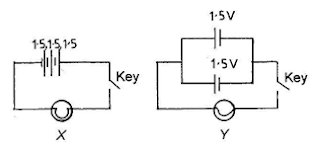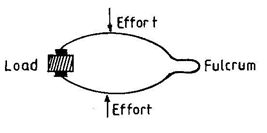BECE 2004 Integrated (Int) Science Paper 1 Objectives
BECE PAST QUESTIONS AND ANSWERS
BECE 2004 INTEGRATED SCIENCE
OBJECTIVES - Paper 1
1.
Which of the following processes of conversion of the states
of matter is correct?
A.
Solid (heat) → gas (heat) → liquid
B.
Solid (cool) → liquid
(cool) → gas
C.
Gas (heat) → liquid
(heat) → solid
D.
Gas (cool) → liquid
(cool) → solid
2.
The types of energy produced when the hands are vigorously
rubbed against each other are
A.
chemical and electrical energy
B.
heat and sound energy
C.
heat and light energy
D.
electrical and light energy
3.
When a thermometer is put in hot water, the mercury level
rises because the mercury increases in
A.
density B.
mass C.
volume D.
weight
4.
The modes of heat transfer involved in the process of heating
water in a bucket from the bottom until it boils are
A. conduction
and convection
B.
conduction and radiation
C.
convection and radiation
D.
conduction, convection and radiation
5.
Which of the following items converts chemical energy to
electrical energy?
A.
Dry cell B. Electric
bulb C. Loudspeaker
D. Microphone
Use the diagrams below to answer Questions 6 and 7
6.
Which of the following statements is correct about the
circuit diagrams above? The cells in diagram
A.
X are in series and the key is open
B.
X are in parallel and the key is open
C.
Y are in series and the key is closed
D.
Y are in parallel and the key is closed
7.
The total emf of
the cells in diagram Y is
A.
4.50 V B. 3.00
V C. 1.50
V D. 0.75
V
8.
It is easier to move a heavy load with a crowbar when
the
A.
effort distance is shorter than the load distance
B.
effort distance is longer than the load distance
C.
effort distance is equal to the load distance
D.
effort is equal to the load
9.
The type of lever shown
above is a
A.
first class lever
B.
second class lever
C.
third class lever
D.
combination of first and second class levers
10.
A balanced diet is one which is made up of
A.
right proportions of protein, carbohydratesLever and oil
B.
equal amounts of protein, carbohydrates and oil
C.
enough water and iodated salt
D.
vegetables, fruits and water
11.
Benedict’s solution was added to a mixture in a test tube and
it turned brick red when heated. The mixture is likely to contain
A.
glucose B. oil
C. protein
D. vitamin
12.
The main food substance present in the albumen of an egg
is
A. carbohydrates B.
fat C. protein
D. vitamin
13.
One characteristic which is not common to all living things
is the ability to
A.
grow B.
move about C. respire D. respond to stimuli
14.
The ovules in a flower develop to form the
A.
fruit B.
leaves C.
seeds D. stem
15.
Onions are planted by means of
A.
bulbs B.
corms C.
suckers D.
rhizomes
16.
The testis in mammals produces
A.
blood B. lymph C.
sperms D.
urine
17.
Which of the following structures takes part in human
digestion?
A.
Caecum B. Kidney
C.
Larynx D.
Pancreas
18.
Which of the following diseases is contracted through sex?
A.
HIV/AIDS B.
Asthma C.
Tuberculosis D. Goitre
19.
Chlorine gas is an example of
A.
an atom B. an element C. a compound
D.
a molecule
20.
The bad smell that comes out of a urinal is due to the
presence of
A.
ammonia B.
hydrogen C. carbon
dioxide D.
nitrogen
21.
The systematic name of the compound FeS is
A.
iron (I) sulphide
B.
iron (II) sulphide
C.
iron (III) sulphide
D.
iron (IV) sulphide
22.
Which of the following elements is a liquid at room
temperature?
A.
Carbon B. Mercury
C.
Silver D.
Sulphur
23.
The type of cloud that gives rain is
A.
cumulus B.
cirrus C. nimbus
D.
stratus
24.
Water drains faster through sand than clay because
A.
sand particles are rougher
B.
sand contains more air spaces
C.
clay particles are smoother
D.
clay particles are bigger
25.
Which of the following organisms is not an animal parasite?
A.
tick B.
tapeworm C. plasmodium
D.
weevil
26.
The housefly is an agent for the spread of
A.
cholera B. malaria C.
measles D.
tuberculosis
27.
The best method
for checking erosion on a slope is
A.
cover cropping B.
mixed cropping C. contour
ploughing D. mulching
28.
It is not advisable to sleep in a closed dark room with green
plants because, the plants
A.
produce heat
B.
compete with human beings for oxygen
C.
absorb water vapour
D.
produce carbon dioxide
29.
The process whereby soil is formed by the breakdown of rocks
is called
A.
composting B.
erosion C. leaching D.
weathering
30.
Kerosene is able to reach the other end of a wick by
A.
diffusion
B.
suction pressure
C.
capillary action
D.
osmosis
31.
The force, which opposes the motion of one body on another
body is called
A.
adhesion B.
cohesion C. friction D.
tension
32.
The work done when a force moves a body through a distance of
12 m is 720 J. The force applied is
A.
8640 N B.
732 N C.
708 N D.
60 N
33.
Food substances are transported from the leaves to various
parts of a plant through the
A.
cambium B.
epidermis C. phloem D.
xylem
34.
Which of the following substances are carried by the blood?
I.
Nutrients
II.
Urine
III.
Oxygen
IV.
Carbon dioxide
A.
II and III only
B.
I, II and IV only
C.
I and III only
D.
I, III and IV only
35.
A uniform mixture of two or more metals is called
A.
an alloy
B.
a colloid
C.
an aerosol
D.
a compound
36.
Gold is usually used to make jewellery because it is
A.
precious
B.
expensive
C.
less reactive with air
D.
a good conductor of heat
37.
Which of the following substances is a non-metal?
A.
Diamond B.
Mercury C. Sodium D.
Steel
38.
Alum is added to water during treatment to
A.
kill germs
B.
help suspended particles to settle
C.
make the water colourless
D.
give taste to the water
39.
Which of the following types of water would be most contaminated by waste substances?
A.
Rain water
B.
Stream water
C.
Bore hole water
D.
Pipe borne water
40.
The method of preserving food by drying is similar to salting
because in both cases germs are
A.
deprived of the air needed for growth
B.
deprived of the water needed for growth
C.
destroyed at high temperatures
D.
destroyed at low temperatures




.webp)








Which of the following item converts chemical energy to eletric energy
ReplyDelete